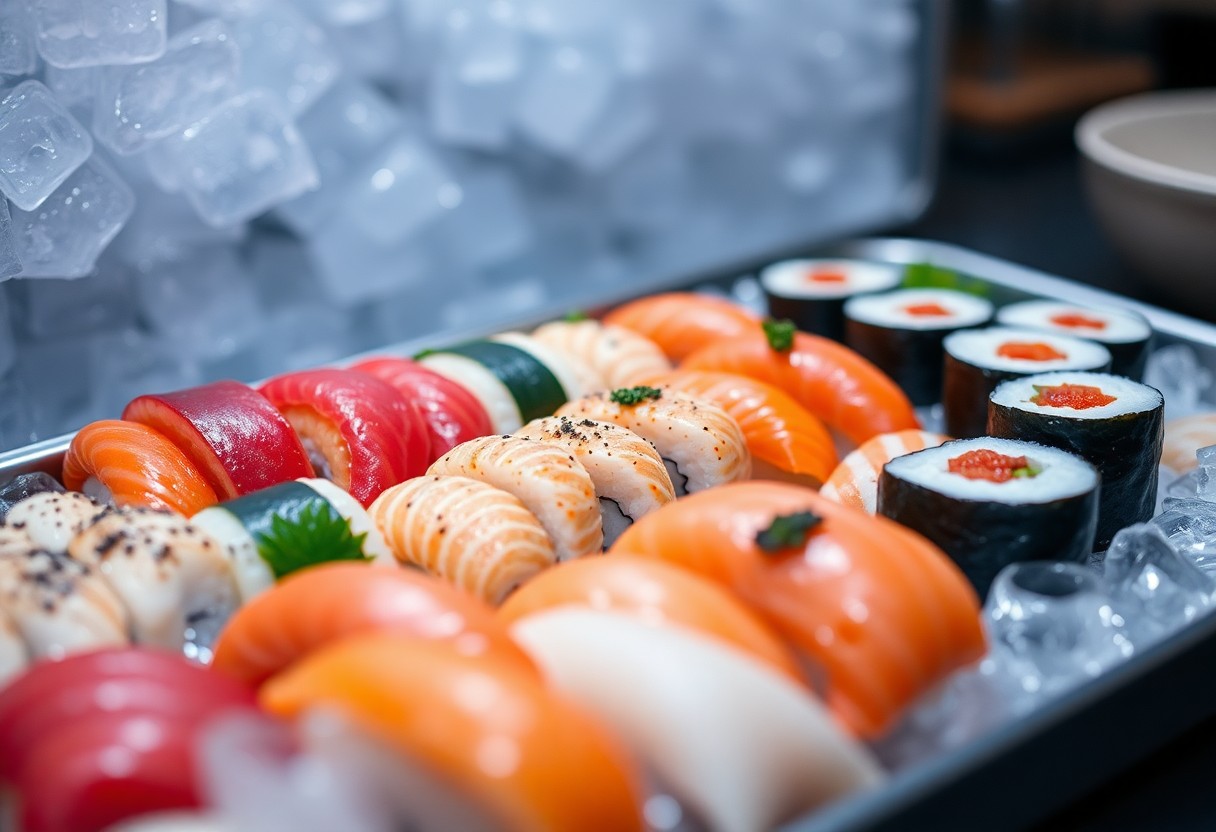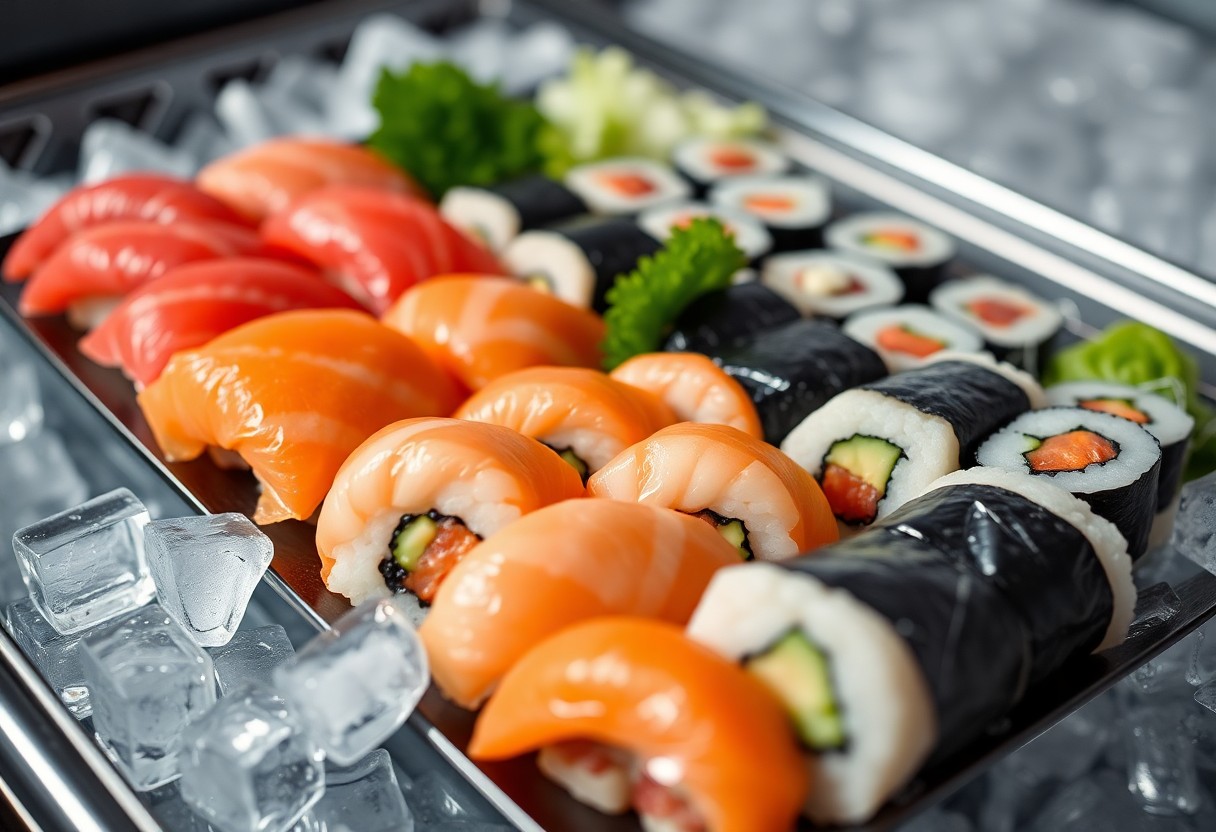Many sushi enthusiasts wonder whether it’s possible to freeze leftover sushi without sacrificing its quality. If you’re faced with a sushi surplus, this guide will provide you with the information you need to make an informed decision. Learn about the best practices for freezing sushi, how to preserve its freshness, and the various impacts freezing can have on different types of sushi. By understanding these points, you can enjoy your sushi creations even when stored for later consumption.
Understanding Sushi Types
While sushi is a delightful culinary experience, it’s vital to understand the various types available. Each sushi type highlights different ingredients and preparation methods, making your choices diverse and interesting. Here’s a quick breakdown:
| Type | Description |
| Sashimi | Thinly sliced raw fish, served without rice. |
| Maki Sushi | Rolls of sushi rice and fillings wrapped in seaweed. |
| Temaki | Hand-rolled cones of seaweed filled with rice and ingredients. |
| Nigiri | Hand-formed rice topped with a slice of raw fish. |
| Uramaki | Inside-out rolls with rice on the outside. |
This variety allows you to explore different flavors and textures as you enjoy sushi.
Raw vs. Cooked Sushi
Types of sushi can be classified into raw and cooked varieties. Raw sushi, such as sashimi and nigiri, features uncooked fish or seafood, offering fresh and vibrant flavors. On the other hand, cooked sushi includes options like ebi (shrimp) and unagi (grilled eel), which can provide a delicious alternative for those hesitant about raw fish.
Sushi Ingredients and Freshness
Sushi relies heavily on high-quality ingredients and their freshness. You should always use fresh seafood and vegetables to ensure the best taste and safety in your sushi preparation. Choosing sushi-grade fish is vital to avoid health risks associated with raw consumption.
It’s vital to source your ingredients from trusted suppliers and pay attention to their storage conditions. Fresh seafood not only enhances flavor but also contributes to the overall quality of your sushi. The balance of fresh ingredients will create a delightful experience that showcases the artistry of sushi-making.
Freezing Sushi: Is It Safe?
The safety of freezing sushi largely depends on the ingredients used and how it’s prepared. While freezing can help prevent the growth of harmful bacteria and parasites, it’s imperative to follow proper food safety guidelines. Utilizing high-quality, sushi-grade fish and adhering to safe freezing techniques can help maintain its safety for consumption, but be sure to check for freshness before making the decision to freeze.
Food Safety Considerations
Against common belief, freezing sushi can be safe, but it requires adherence to specific food safety measures. Ensure that you use sushi-grade fish recognized as safe for raw consumption. It’s also advisable to freeze the sushi quickly after preparation to minimize any risk of spoilage, while maintaining careful monitoring of your freezer’s temperature to keep it consistently at 0°F or below.
Impact on Texture and Flavor
The freezing process can significantly alter the texture and flavor of sushi. When you freeze sushi, ice crystals form within the ingredients, which can disrupt the delicate composition of fish and rice. As a result, you may find that your sushi loses some of its original freshness and becomes watery or mushy upon thawing, diminishing its overall quality and enjoyment.
Understanding how freezing affects sushi is important for achieving the best results. The delicate structure of sushi rice can break down during the freezing process, resulting in a change in texture that may not align with your expectations. Additionally, flavors can become muted or even off, particularly in rolls with fresh ingredients like vegetables and herbs. If you choose to freeze sushi, consider enjoying it in a cooked or transformed state to maximize flavor and texture.

How to Properly Freeze Sushi
Now that you’re considering freezing sushi, it’s important to follow the right steps to ensure the best quality upon thawing. Start by determining the type of sushi you have; rolls containing raw fish should be treated with particular care. Quick work is important—freeze your sushi as soon as possible to preserve its freshness. You’ll want to package it properly to avoid freezer burn and maintain flavor. Choose an airtight container or heavy-duty freezer bags, and make sure to eliminate excess air before sealing.
Preparation and Packaging
Behind every successful sushi freezing process lies the proper preparation and packaging. First, slice your sushi into individual pieces if it’s a roll—this will make it easier to defrost later. Next, place your sushi in a single layer on a baking sheet lined with parchment paper. Freeze the pieces for about an hour until they’re solid, then transfer them into airtight containers or freezer bags. By doing this, you keep the flavors intact and avoid squished sushi during storage.
Recommended Freezing Techniques
Techniques for freezing sushi effectively vary depending on the type, but a few methods stand out. You can freeze sushi rolls or nigiri individually for easy access later or create a sushi block by layering pieces in a freezer bag. If you plan to keep your sushi for longer than a month, consider flash-freezing as it locks in flavors and textures. Store sushi with like ingredients together, and label each package with the date to keep track of freshness.
Preparation for freezing sushi is key to maintaining its quality. Consider using a vacuum sealer if you have one, as it removes air and further prevents freezer burn. If your sushi contains ingredients like avocado or cucumber, note that these may become softer when defrosted but will still taste great. Always aim to consume frozen sushi within three months for optimum flavor, and when you’re ready to enjoy, simply defrost it in the refrigerator overnight for best results.
Thawing Sushi: Best Practices
Unlike fresh sushi, thawing frozen sushi requires careful handling to preserve its taste and texture. Proper thawing allows you to enjoy your sushi without compromising the quality or safety of the ingredients. You should plan ahead to ensure a delightful dining experience.
Safe Thawing Methods
An effective method for thawing sushi is to place it in the refrigerator for several hours or overnight. This gradual thawing process helps maintain the natural flavors and textures of the fish and rice, making it safer for consumption.
Tips for Maintaining Quality
On your journey to perfect sushi thawing, consider these vital tips:
- Avoid using a microwave or hot water, as these methods can alter the texture.
- Keep sushi tightly wrapped to retain moisture and flavors.
- Thaw only the amount you plan to eat to prevent refreezing.
Any deviations from these steps may lead to less satisfying results.
Thawing your sushi with care contributes significantly to its quality. Focus on maintaining the integrity of the ingredients by following these guidelines:
- Serve thawed sushi at room temperature to enhance flavor.
- Consider pairing with fresh ingredients, such as wasabi or soy sauce, to elevate the experience.
- Keep an eye on any signs of spoilage before consuming.
Any overlooked detail can affect your overall enjoyment of the dish.

Alternatives to Freezing Sushi
Once again, freezing sushi may not be the best option for preserving its quality. Instead, consider alternatives that maintain the freshness of your seafood and rice. For instance, you can consume leftover sushi within a day or two, or store it in the refrigerator for short periods. By opting for these alternatives, you ensure the delicate flavors and textures of your sushi remain intact.
Short-term Storage Options
For short-term storage, keep your sushi in an airtight container and refrigerate it. Ensure you consume it within 24 hours to enjoy the best taste and texture. Avoid overexposure to air, as this can lead to drying out and decrease its flavors significantly.
Making Sushi in Small Batches
With small batches, you can create just enough sushi to enjoy in one meal, reducing waste and maintaining optimal freshness. This approach allows you to play with different ingredients and flavors, keeping your meals exciting without the concerns of storage.
Also, making sushi in small batches gives you the advantage of experimentation. You can try new recipes or variations without committing to large quantities. This way, you can enjoy freshly prepared sushi that’s tailored to your taste preferences while minimizing leftovers that won’t be as enjoyable the next day. It’s a fun and effective way to master your sushi-making skills!
Frequently Asked Questions
To help clarify any uncertainties you may have about freezing sushi, this section addresses common questions that arise. Understanding the process and implications of freezing sushi can enhance your experience and ensure you enjoy this culinary delight the right way.
Common Concerns and Myths
For many, the notion of freezing sushi raises concerns and myths about its safety and quality. You might worry that freezing will compromise the flavors and textures, or even that it could lead to foodborne illnesses. It’s imperative to differentiate between fact and fiction when it comes to storing your favorite sushi.
Expert Opinions
Between culinary experts and sushi chefs, opinions on freezing sushi vary widely. While some caution against it due to potential texture changes, others suggest it can be done safely with the right techniques in mind. You should seek dependable advice to make informed decisions.
Due to differing perspectives, you will find that some experts advocate for freezing sushi to extend its shelf life, particularly for vegetable rolls or cooked sushi. However, they emphasize the importance of using high-quality, fresh ingredients before freezing and consuming your sushi as quickly as possible to preserve its taste and safety. Following proper freezing methods alongside expert recommendations can help enhance your sushi experience.





Leave a Reply